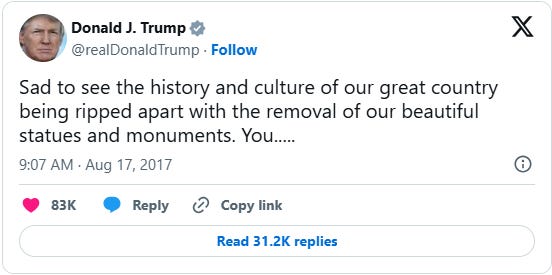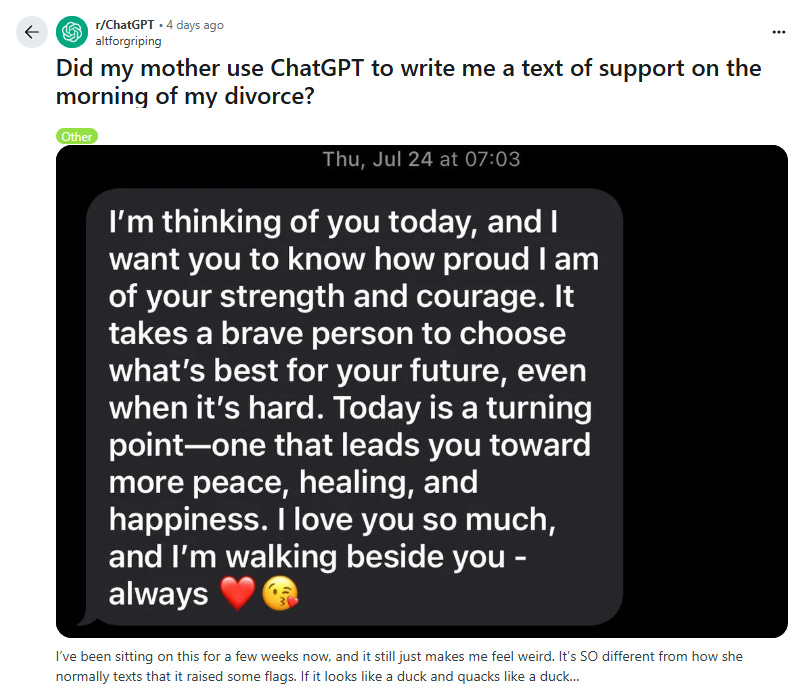Who Asked For This? Two Stories.
Honoring a Confederate traitor and an AI ghost of a dead kid: Things we didn't ask for and don't want.
Thank you for reading The Cross Section. This site has no paywall, so I depend on the generosity of readers to sustain the work I present here. If you find what you read valuable and would like it to continue, consider becoming a paid subscriber.
Story #1: The Party of Treason
Donald Trump fondly remembers warm summer nights sitting on the porch with his grandpappy, who whittled in his rocking chair while telling tales of the noble Trump ancestors and their fight for self-determination. “When you see them Stars and Bars, remember Donny, that’s your heritage,” Pawpaw would say. “The War Between the States was the most noble fight man ever fought. And I’ll tell you a secret: It ain’t over. It ain’t never over.” Donny silently promised himself that if he ever had a chance to restore the Confederacy to its rightful place of honor, he’d move heaven and earth to do it.
Okay, that’s not actually what happened — Trump is a son of Queens, a Northerner through-and-through. There’s no public record telling us when the light of the angel Jefferson Davis fell upon him and he knew that the Confederacy’s cause was his own, but it sure is now.
After renaming a bunch of military facilities for Confederate traitors who waged war on America, the administration is apparently casting about for any way it can celebrate the Confederacy:
WASHINGTON (AP) — Two Washington, D.C.-area statues commemorating the Confederacy will be restored and replaced, in line with President Donald Trump’s pushback on recent efforts to reframe America’s historical narrative.
Defense Secretary Pete Hegseth announced Tuesday that a statue commemorating the Confederacy would be returned to Arlington National Cemetery. The statue, which Hegseth referred to as “The Reconciliation Monument,” was removed in 2023.
The National Park Service announced Monday that the statue of Albert Pike, a Confederate brigadier general and a revered figure among Freemasons, would resume its previous position in Washington’s Judiciary Square, a few blocks from the U.S. Capitol. It was the only outdoor statue of a Confederate military leader in the nation’s capital.
Who asked for this? I’m guessing that if you asked 10,000 Americans who Albert Pike was, maybe one or two at most could have told you. But here’s who he was: a white supremacist, an advocate of slavery, a traitor to the United States, a general in the army that waged war against America, and a key figure in the early Ku Klux Klan. Pike wrote in 1868 that “the white race, and that race alone, shall govern this country. It is the only one that is fit to govern, and it is the only one that shall.”
Pike’s statue was torn down by protesters in 2020. We don’t know who in the administration said “Hey, what if we put the statue of that white supremacist traitor back up?”, but I have no doubt that when the idea was presented to the president, he couldn’t have been more pleased.
But it’s not as though the missing Pike statue was a festering wound that the Trump base could not abide a moment longer. I may be incorrect on this, but my sense is that the number of genuinely passionate Confederacy advocates is pretty small, particularly outside the South. They’re there, but it’s not like huge portions of the electorate care deeply about whether there’s a statue to Whitey McSlaveowner in their town square. If you ask them, most Republicans will express support for celebrating the Confederacy — in one 2020 poll, 80% of Republicans opposed removing Confederate statues — but it’s not on their minds every day. If Trump had not bothered to rename the bases or put back this statue, it isn’t as though his large contingent of racist supporters would decide he hadn’t really delivered for them.
But Trump has been talking about Confederate statues for a long time:
What he knows by now is that these controversies are a great way to pander to his party’s bigots while paying little or no price. When liberals object, his base loves it, because they’ve been trained to view trolling as the highest form of political engagement. And the elite media renders no value judgment at all; at most, his words and actions will be described as “wading into the culture wars,” and there might be an editorial gently suggesting that “there are better ways to unite the country, Mr. President.”
So hey, elected Democrats: You might want to speak plainly about this. You can say, “Donald Trump is erecting a statue to a white supremacist traitor who was in the KKK. Why does he hate America so much?” And if your response to that is “Oh no, someone might say we’re being divisive!”, the answer is, yes that would be divisive, in a good way. Otherwise you’re letting him get away with it.
Story #2: Today’s AI nightmare
On Tuesday, erstwhile CNN reporter and current independent journalist Jim Acosta posted on his Substack an “interview” with a crude AI replica of Joaquin Oliver, a young man who was killed in the Parkland high school shooting in 2018. The AI…whatever you want to call it…was created by Oliver’s parents as a tool to draw attention to gun violence. Here’s a clip, if you can stomach it:
While no one wants to criticize Oliver’s parents, condemnation of Acosta has been pretty much universal, and completely justified; I won’t offer my own two cents since others have said what needs to be said (I’d recommend Parker Malloy’s comprehensive take). But I do want to point out that in a very short amount of time, this kind of thing is going to become utterly ubiquitous. We have not yet begun to grapple with the ways the thoughtless use of AI will infect and degrade so many of the rituals, habits, and simple daily interactions that make up the experience of being human.
Despite the many ways AI is being overhyped, this much is true: The ability of AI systems to reproduce a convincing facsimile of a particular individual — their image, their voice — from a very small corpus of source material has already improved to a stunning degree, and will only improve. It wasn’t that long ago that if someone wanted to produce a deepfake of a person speaking words they had never spoken, they had to use a public figure for whom there are hours and hours of recordings of them talking. Here’s a video researchers at the University of Washington created in 2017 of Barack Obama; they used him because there was plenty of source material available:
The response at the time was basically “Holy crap, look what they can do now!” But today, you don’t need hours of video; the systems can do pretty much the same thing with a short clip of somebody talking, downloaded from their Insta, or somebody else’s Insta. A year from now, what those systems can produce will look even better than they do now, and a year after that it’ll be even better.
The implications for politics, media, and our ability to sort truth from lies are so vast that it’s difficult to wrap your head around them. But let me suggest just one possibility.
Have you been to a really good funeral? If you have, you know how meaningful they can be. The stories the loved ones tell, the way it highlights the departed’s importance in their community and their effect on the lives of others, the insights people bring about the one you’re there to celebrate — it can not only be immensely healing, but it can color how you remember your loved one for years, maybe forever.
Now let me offer a prediction. Ten years from now, almost every funeral you go to will include an AI-generated video message from the deceased. And probably some weddings, too — Grandma died three years ago, but here she is to tell us how happy she’d be today! Some families will put a great deal of care into these videos — writing the script, giving thought to the visual details — while others will find it easier to just ask the latest chatbot to create it with as little input as possible. People are already using chatbots for very personal things:
Sure, some intellectuals and hippies will resist the allure of the AI-generated video message of the deceased. But it will become the norm, to the point where you’ll be surprised if a funeral doesn’t have a message from the beyond as its centerpiece. Funeral homes will offer it as a service — give us the outfit you want your loved one buried in and links to a social media video or two, and we’ll do the rest.
We’re all going to have to figure out where our own personal red lines are in the world we’re hurtling toward, but it’s going to be a rare corner of human interaction that isn’t infected by AI to one degree or another. Just a heads-up.





Another great column, Paul.
There are several very well done books about the "Lost Cause" narrative about the Confederacy. Read any one of them and you can only conclude that Jefferson Davis, Robert E. Lee and all of his generals and senior officers, should have been hung for treason. That would have been the only way to have ended the myths and lies that persist until today.